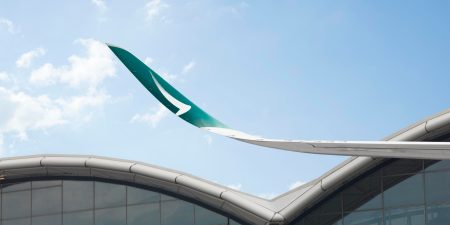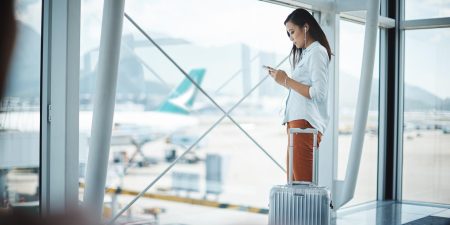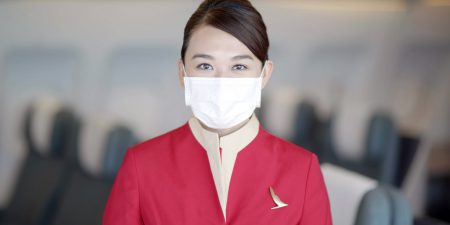Cathay Pacific announces 2011 annual results
The Cathay Pacific Group recorded an attributable profit of HK$5,501 million for 2011. This compares to the profit of HK$14,048 million for 2010, which was a record year for the airline. The 2010 results included HK$3,033 million of significant non-recurring items being the profit on the sales of our shareholdings in Hong Kong Air Cargo Terminals Limited and Hong Kong Aircraft Engineering Company Limited and the gain on the deemed disposal of part of our interest in Air China. Adjusting for these items, the attributable profit in 2011 decreased by HK$5,514 million or 50.1% from 2010. Turnover for the year increased by 9.9% to HK$98,406 million. Earnings per share fell by 60.9% to HK139.8 cents.
In 2011 the core business of the Cathay Pacific Group was materially affected by instability and uncertainty in the world’s major economies. The passenger business of Cathay Pacific and Dragonair held up relatively well, mainly as a result of strong demand for premium class travel. Cargo business was adversely affected by a substantial reduction in demand for shipments from the two key export markets of Hong Kong and Mainland China.
Cathay Pacific Chairman Christopher Pratt said: “We faced a number of major challenges in 2011 and we are still operating in a very challenging environment, particularly for our cargo business. However, the Cathay Pacific Group has a clear strategic focus and we are moving ahead with a number of initiatives that will make our airlines stronger and provide a better experience for our customers. For example, the Group is taking delivery of 19 new aircraft in 2012; we are introducing a new premium economy class product, new long-haul economy class seats and continuing with the rollout of our acclaimed new business class; we are improving our lounge facilities; and we are building one of the world’s most sophisticated cargo terminals in Hong Kong that is on track to open early in 2013. For Dragonair, we will add more aircraft, launch new products and introduce new destinations this year, all of which will improve connectivity and boost Hong Kong’s role as one of the world’s premier international aviation hubs.”
Fuel is the Group’s biggest single cost and the persistently high jet fuel prices had a significant effect on our operating results in 2011. Disregarding the effect of fuel hedging, the Group’s gross fuel costs increased by HK$12,455 million (or 44.1%) in 2011. The increase reflected both higher fuel prices and the fact that more flights were operated. Managing the risk associated with changing fuel prices remains a high priority and to this end the Group has an active fuel hedging programme in place. In 2011 it realised a profit of HK$1,813 million from fuel hedging activities, with additional unrealised mark-to-market gains of HK$436 million in the reserves at 31st December 2011.
Passenger revenue for the year was HK$67,778 million, an increase of 14.2% compared with 2010. Capacity increased by 9.2%. The two airlines carried a total of 27.6 million passengers, a rise of 2.9% compared with 2010, but the load factor fell by 3.0 percentage points. Yield increased by 8.7% to HK66.5 cents. The relative strength of a number of the currencies in which Cathay Pacific receives revenues made a positive contribution. Demand for premium class travel remained robust in 2011, and the firm demand for Business Class seats on short-haul routes reflected the relative strength of the Asian economy. Load factors in Economy Class remained generally high, particularly on the North American and Southeast Asian routes. However, there was a reduction in Economy Class yield on long-haul routes. Business was also affected by the natural disasters in Japan and Thailand. Cathay Pacific continued to develop its passenger network, launching two new routes in 2011 - Abu Dhabi and Chicago – and increasing frequencies on other key routes.
The cargo business of the Group performed reasonably well in the first quarter of 2011. However, from April onwards, demand for shipments from its two most important markets, Hong Kong and Mainland China, weakened significantly and remained weak for the rest of the year. Cargo revenue for 2011 increased by 0.3% to HK$25,980 million compared with 2010. Yield was up by 3.9% to HK$2.42. Capacity increased by 6.9%. The load factor, however, fell by 8.5 percentage points to 67.2%. Capacity was managed in order to keep it in line with demand. In 2011 Cathay Pacific started cargo services to Bengaluru in India, Chongqing and Chengdu in Western China and Zaragoza in Spain.
The Group continues to acquire new aircraft to replace older, less efficient aircraft and to increase the size of the fleet. In 2011 it took delivery of six Boeing 777-300ERs, three Airbus A330-300s and four Boeing 747-8F freighters. Two new Airbus A320-200s joined the Dragonair fleet in February 2012. In March 2011, we announced orders for 27 new aircraft, including two Airbus A350-900s (which had been ordered in December 2010), 15 Airbus A330-300s and 10 Boeing 777-300ERs. In August 2011, we announced the acquisition of four more Boeing 777-300ERs and eight Boeing 777-200F freighters. In January 2012, the purchase of six more Airbus A350-900s was announced, for delivery in 2016 and 2017 and agreed to lease two new Airbus A320-200s to be delivered later in 2012. By 2019, the Group intends to be operating one of the youngest, most fuel-efficient wide-body passenger fleets in the world.
The airline also has eight Boeing 777-200F freighters on order in addition to the 10 Boeing 747-8F freighter referred to above. To demonstrate its long-term confidence in Hong Kong as an air cargo hub, Cathay Pacific is building its own cargo terminal at Hong Kong International Airport. The terminal is expected to begin operations in early 2013.
The airline has continued its efforts to improve the services it provides to passengers. In March 2011, Cathay Pacific introduced its new Business Class seat and from February 2012 began installing new Premium Economy Class cabins on long-haul aircraft. The new cabins are expected to be installed in 87 aircraft by the end of 2013. New medium- and long-haul Economy Class seats were also introduced in March 2012 and are now being progressively installed on Boeing 777-300ER and Airbus A330-300 long-haul aircraft.
Air China plays an increasingly important role in the Cathay Pacific Group’s business, having contributed 31.1% of our consolidated profit before tax in 2011. Air China and Cathay Pacific continue to work together closely. The cargo joint venture with Air China, in which Cathay Pacific owns an equity and an economic interest, was formally approved and established in February and officially launched in May 2011. The joint venture operates from Shanghai under the Air China Cargo name.
Mr Pratt added: “After a record year in 2010, we faced a number of major challenges in 2011: the instability of the global economy, the weakness of the air cargo market, the reduction of yields in economy class, the impact of natural disasters in Japan and Thailand, unrest in the Middle East and continued high jet fuel prices. Looking ahead, economic uncertainties have continued into the first half of this year - while these uncertainties continue, we expect pressure on economy class yields and our cargo business in particular to remain weak. Fuel prices have risen further. As a result, 2012 is looking even more challenging than 2011 and we are therefore cautious about prospects for this year. We will continue to be vigilant in managing our costs while not compromising the quality of our products and services or our long-term strategic investment in the business. Our financial position remains strong. In August 2011, we established a medium term note programme. The programme provides an additional source of funding and allows the Company to issue debt in a range of currencies. The first issue of notes under the programme took place in October 2011. Further notes were issued in January and February 2012.”
Cathay Pacific 2011 Annual Results









